胸腔闭式引流术知情同意书
- 格式:doc
- 大小:36.50 KB
- 文档页数:2
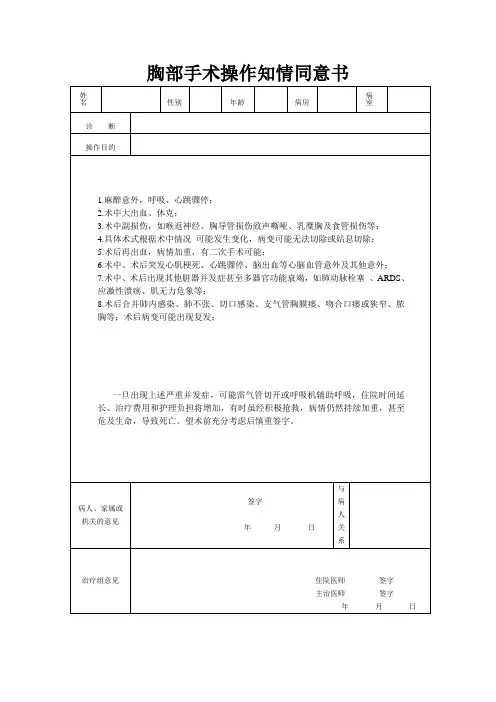
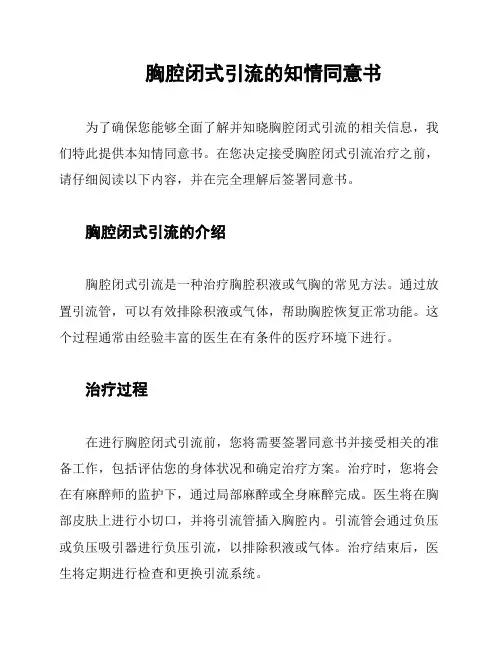
胸腔闭式引流的知情同意书为了确保您能够全面了解并知晓胸腔闭式引流的相关信息,我们特此提供本知情同意书。
在您决定接受胸腔闭式引流治疗之前,请仔细阅读以下内容,并在完全理解后签署同意书。
胸腔闭式引流的介绍胸腔闭式引流是一种治疗胸腔积液或气胸的常见方法。
通过放置引流管,可以有效排除积液或气体,帮助胸腔恢复正常功能。
这个过程通常由经验丰富的医生在有条件的医疗环境下进行。
治疗过程在进行胸腔闭式引流前,您将需要签署同意书并接受相关的准备工作,包括评估您的身体状况和确定治疗方案。
治疗时,您将会在有麻醉师的监护下,通过局部麻醉或全身麻醉完成。
医生将在胸部皮肤上进行小切口,并将引流管插入胸腔内。
引流管会通过负压或负压吸引器进行负压引流,以排除积液或气体。
治疗结束后,医生将定期进行检查和更换引流系统。
风险和并发症胸腔闭式引流是一种常见且相对安全的治疗方法,但仍存在一些风险和并发症,包括但不限于感染、出血、胸膜损伤、肺受压或塌陷、气胸、癌症细胞扩散等。
这些风险和并发症可能会根据个人情况而有所不同,请您在决定接受治疗之前与主治医生充分沟通。
替代方案除胸腔闭式引流外,还存在其他治疗胸腔积液或气胸的替代方案,如手术胸腔引流、胸腔注射治疗等。
在决定接受治疗之前,请与主治医师讨论您的选择,并了解每种治疗方法的优缺点。
同意与拒绝权签署本知情同意书并不强制要求您接受胸腔闭式引流治疗。
您有权拒绝治疗,或与医生进一步讨论治疗安排。
如果您有任何疑问或担忧,请随时与医生沟通,或咨询其他医疗专家。
我已经仔细阅读并理解了上述信息,并同意接受胸腔闭式引流治疗。
______________________________患者签名)______________________________日期)______________________________医生签名)______________________________日期)。
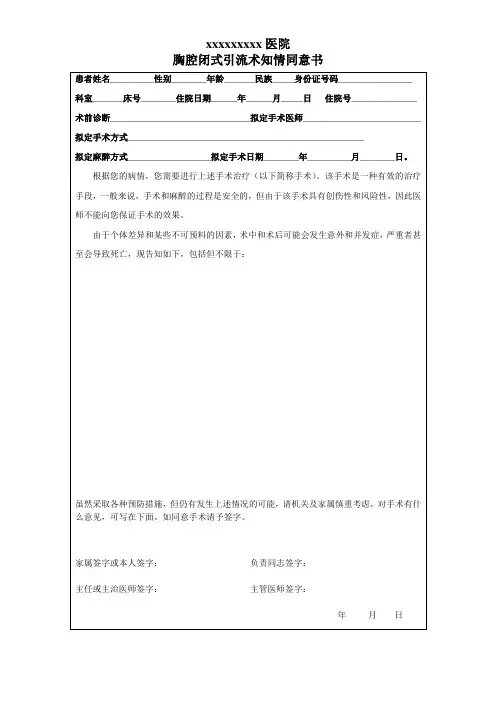
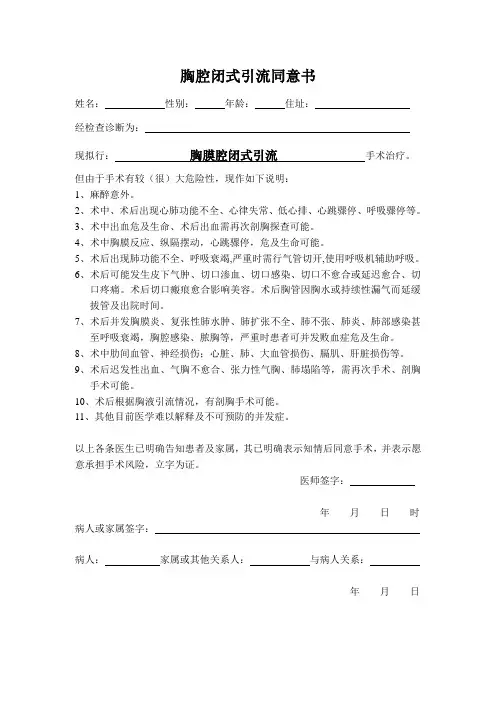
胸腔闭式引流同意书
姓名:性别:年龄:住址:
经检查诊断为:
现拟行:胸膜腔闭式引流手术治疗。
但由于手术有较(很)大危险性,现作如下说明:
1、麻醉意外。
2、术中、术后出现心肺功能不全、心律失常、低心排、心跳骤停、呼吸骤停等。
3、术中出血危及生命、术后出血需再次剖胸探查可能。
4、术中胸膜反应、纵隔摆动,心跳骤停,危及生命可能。
5、术后出现肺功能不全、呼吸衰竭,严重时需行气管切开,使用呼吸机辅助呼吸。
6、术后可能发生皮下气肿、切口渗血、切口感染、切口不愈合或延迟愈合、切
口疼痛。
术后切口瘢痕愈合影响美容。
术后胸管因胸水或持续性漏气而延缓拔管及出院时间。
7、术后并发胸膜炎、复张性肺水肿、肺扩张不全、肺不张、肺炎、肺部感染甚
至呼吸衰竭,胸腔感染、脓胸等,严重时患者可并发败血症危及生命。
8、术中肋间血管、神经损伤;心脏、肺、大血管损伤、膈肌、肝脏损伤等。
9、术后迟发性出血、气胸不愈合、张力性气胸、肺塌陷等,需再次手术、剖胸
手术可能。
10、术后根据胸液引流情况,有剖胸手术可能。
11、其他目前医学难以解释及不可预防的并发症。
以上各条医生已明确告知患者及家属,其已明确表示知情后同意手术,并表示愿意承担手术风险,立字为证。
医师签字:
年月日时病人或家属签字:
病人:家属或其他关系人:与病人关系:
年月日。
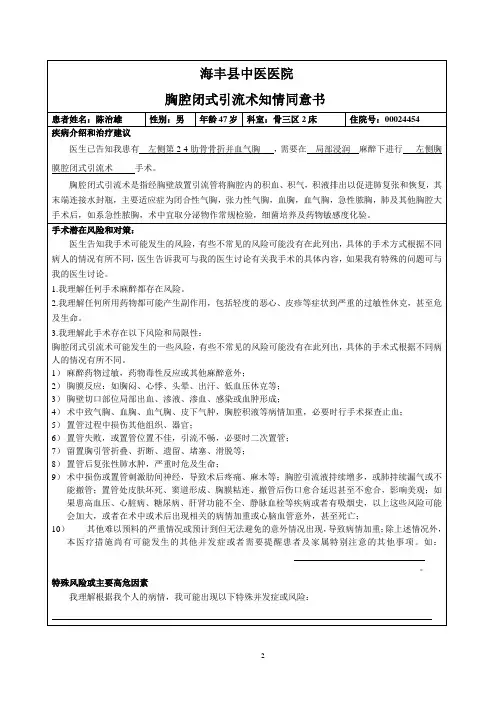
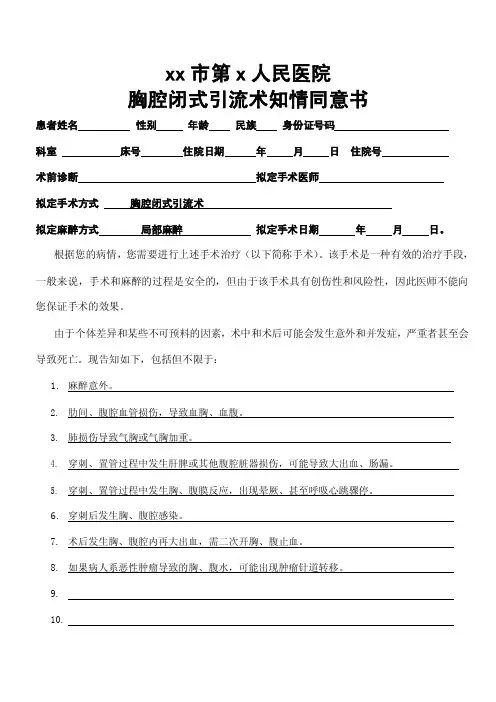
xx市第x人民医院胸腔闭式引流术知情同意书患者姓名性别年龄民族身份证号码科室床号住院日期年月日住院号术前诊断拟定手术医师拟定手术方式胸腔闭式引流术拟定麻醉方式局部麻醉拟定手术日期年月日。
根据您的病情,您需要进行上述手术治疗(以下简称手术)。
该手术是一种有效的治疗手段,一般来说,手术和麻醉的过程是安全的,但由于该手术具有创伤性和风险性,因此医师不能向您保证手术的效果。
由于个体差异和某些不可预料的因素,术中和术后可能会发生意外和并发症,严重者甚至会导致死亡。
现告知如下,包括但不限于:1.麻醉意外。
2.肋间、腹腔血管损伤,导致血胸、血腹。
3.肺损伤导致气胸或气胸加重。
4.穿刺、置管过程中发生肝脾或其他腹腔脏器损伤,可能导致大出血、肠漏。
5.穿刺、置管过程中发生胸、腹膜反应,出现晕厥、甚至呼吸心跳骤停。
6.穿刺后发生胸、腹腔感染。
7.术后发生胸、腹腔内再大出血,需二次开胸、腹止血。
8.如果病人系恶性肿瘤导致的胸、腹水,可能出现肿瘤针道转移。
9.10.本手术提请患者以及亲属注意的其他事项:我已详细阅读以上内容,对医师护士告知表示完全理解,经慎重考虑,我决定做此手术。
我明白在本次手术中,在不可预见的情况下,可能需要其他附加操作或变更手术方案,我授权医师在于有紧急情况时,为保障我的生命安全实施必要的救治措施,并保证承担全部所需费用。
患者签署意见:患者签署姓名:法定代理人签署意见:法定代理人与患者的关系:法定代理人签署姓名:未由患者本人签字的原因:1.患者不具备民事行为能力,由法定代理人签字。
2.患者因病无法签字,由近亲属或者关系人签字。
3.为抢救患者,在法定代理人或近亲属、关系人无法及时签字的情况下,由医疗机构负责人或被授权的负责人签字。
4.因实施保护性医疗措施,未由患者本人签字。
谈话医师签名:主治医师签名:年月日。
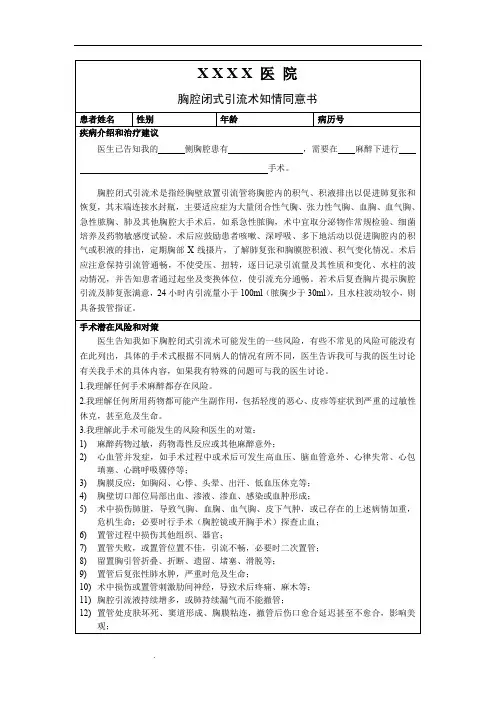
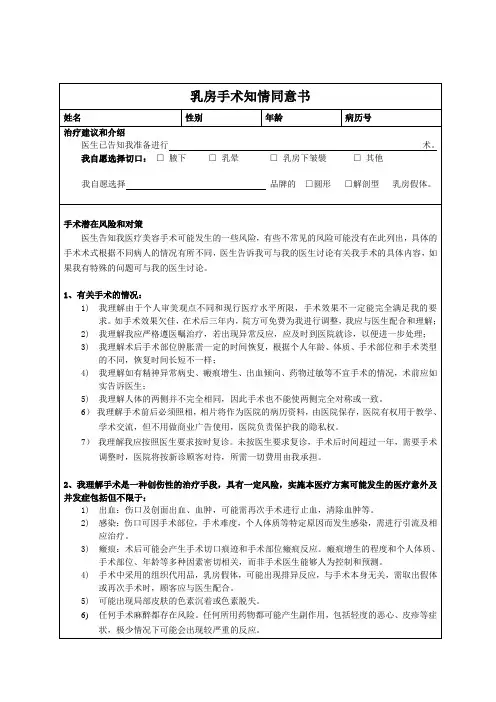
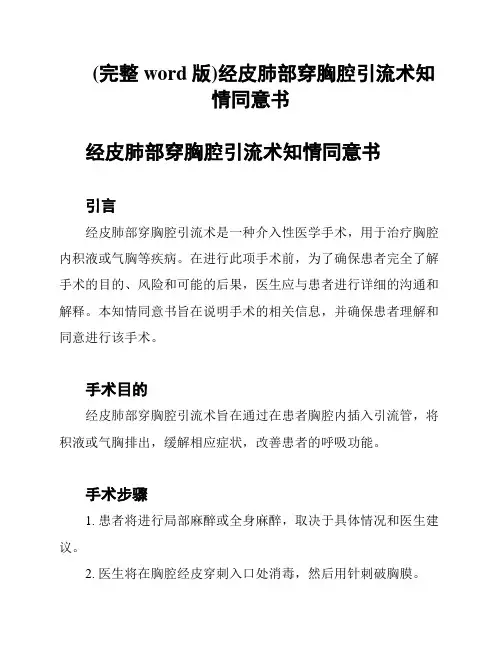
(完整word版)经皮肺部穿胸腔引流术知情同意书经皮肺部穿胸腔引流术知情同意书引言经皮肺部穿胸腔引流术是一种介入性医学手术,用于治疗胸腔内积液或气胸等疾病。
在进行此项手术前,为了确保患者完全了解手术的目的、风险和可能的后果,医生应与患者进行详细的沟通和解释。
本知情同意书旨在说明手术的相关信息,并确保患者理解和同意进行该手术。
手术目的经皮肺部穿胸腔引流术旨在通过在患者胸腔内插入引流管,将积液或气胸排出,缓解相应症状,改善患者的呼吸功能。
手术步骤1. 患者将进行局部麻醉或全身麻醉,取决于具体情况和医生建议。
2. 医生将在胸腔经皮穿刺入口处消毒,然后用针刺破胸膜。
3. 引流管将通过穿刺口插入胸腔,以排出积液或气体。
4. 当医生确认已排除积液或气胸后,引流管将被固定于胸壁上。
5. 手术结束后,会进行适当的处理和包扎伤口。
手术风险尽管经皮肺部穿胸腔引流术是一种相对安全的手术,但仍然存在一定的风险和并发症,包括但不限于以下内容:- 出血:由于手术操作可能会导致血管损伤,可能会引起内出血。
- 感染:在手术过程中,可能会导致伤口感染,需要进行适当的抗生素治疗。
- 气胸:手术操作可能会导致气胸再次发作。
- 非预期伤害:手术操作过程中,可能会对肺部或其他器官造成不可预测的损伤。
术后护理与注意事项- 术后需要休息,避免剧烈运动,以免引发伤口出血。
- 定期更换伤口敷料,并保持伤口干燥和清洁。
- 如果出现伤口红肿、渗液、发热等异常情况,应及时向医生咨询。
- 术后需要按照医生的指示进行药物治疗和康复锻炼。
后果和效果经皮肺部穿胸腔引流术的效果主要取决于患者的具体病情和个体差异,手术后有可能出现以下情况:- 症状明显缓解,呼吸功能明显改善。
- 部分患者可能需要进一步的治疗或手术。
- 部分患者可能会出现术后疼痛或不适感。
放射性辐射安全如果在手术过程中需要使用X射线或其他放射性检查,医生将确保辐射剂量最低限度且符合相关安全标准。
但在任何情况下,应尽量减少辐射对患者及其他人员的影响。
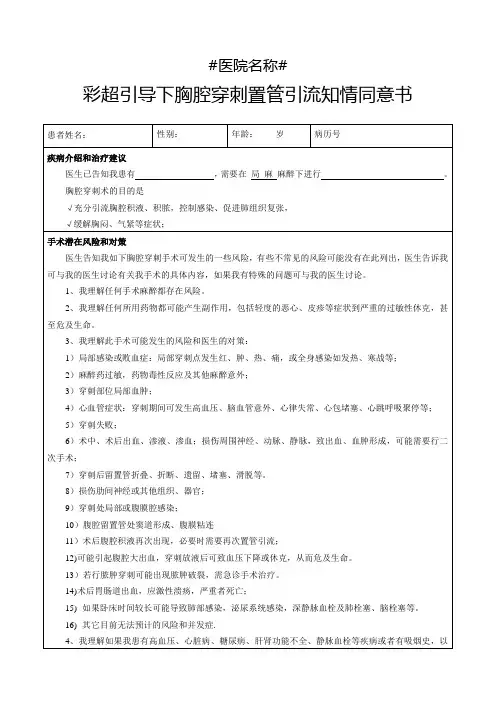
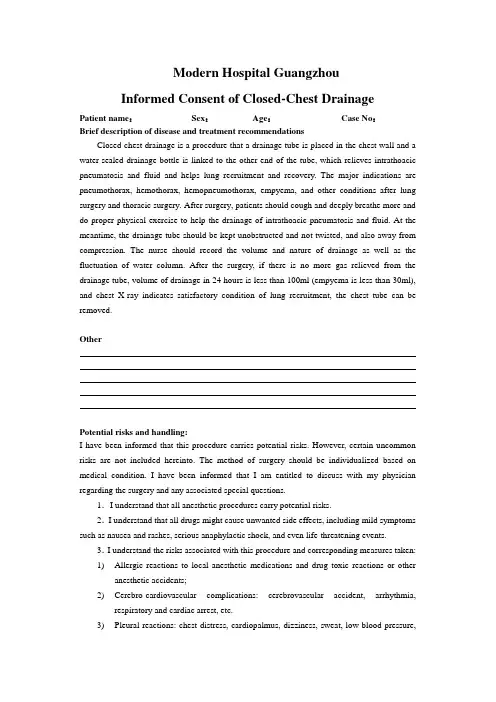
Modern Hospital GuangzhouInformed Consent of Closed-Chest DrainagePatient name:Sex:Age:Case No:Brief description of disease and treatment recommendationsClosed-chest drainage is a procedure that a drainage tube is placed in the chest wall and a water-sealed drainage bottle is linked to the other end of the tube, which relieves intrathoacic pneumatosis and fluid and helps lung recruitment and recovery. The major indications are pneumothorax, hemothorax, hemopneumothorax, empyema, and other conditions after lung surgery and thoracic surgery. After surgery, patients should cough and deeply breathe more and do proper physical exercise to help the drainage of intrathoacic pneumatosis and fluid. At the meantime, the drainage tube should be kept unobstructed and not twisted, and also away from compression. The nurse should record the volume and nature of drainage as well as the fluctuation of water column. After the surgery, if there is no more gas relieved from the drainage tube, volume of drainage in 24 hours is less than 100ml (empyema is less than 30ml), and chest X-ray indicates satisfactory condition of lung recruitment, the chest tube can be removed.OtherPotential risks and handling:I have been informed that this procedure carries potential risks. However, certain uncommon risks are not included hereinto. The method of surgery should be individualized based on medical condition. I have been informed that I am entitled to discuss with my physician regarding the surgery and any associated special questions.1.I understand that all anesthetic procedures carry potential risks.2.I understand that all drugs might cause unwanted side effects, including mild symptoms such as nausea and rashes, serious anaphylactic shock, and even life-threatening events.3.I understand the risks associated with this procedure and corresponding measures taken:1)Allergic reactions to local anesthetic medications and drug toxic reactions or otheranesthetic accidents;2)Cerebro-cardiovascular complications: cerebrovascular accident, arrhythmia,respiratory and cardiac arrest, etc.3)Pleural reactions: chest distress, cardiopalmus, dizziness, sweat, low blood pressure,and shock, etc.4)Local bleeding, effusion, errhysis, infection, or hematoma in incision site of chestwall.5)Injuries to intercostal blood vessels and lungs during the surgery, pneumothorax,hemothorax, pneumohemothorax, subcutaneous emphysema after the surgery, or evensurgical procedures (thoracoscope or thoracotomy) will be adopted in criticalcondition.6)Tight adhesion of thoracic cavity found during the surgery results in unsuccessfulinsertion of drainage tube ;7)Poorly location of drainage tube and inadequate drainage may result in adjustment orreinsertion of drainage tube.8)Breaking, retention and obstruction of puncture needle or drainage tube;9)Reexpansion pulmonary edema after surgery, and life-threatening risk in criticalcondition.10)After the surgery, large amounts of fluid drained continuously, gas leakedcontinuously, or dissatisfactory lung recruitment, results in drainage tube remainingfor long time.11)Injuries or stimulus to intercostal nerves result in pain and numbness after surgery;12)Injuries to other organs in the abdominal cavity, in severe cases, surgery is required;13)Infection of incisional wound and fat liquefaction result in undesirable or delayedhealing of wound;14)Skin necrosis, sinus tract formation, and pleural adhesions in drainage tube site;Delayed union or even disunion of wound and esthetic effection after pulling out thetube.4.I understand that patients with hypertension, heart disease, diabetes, renal insufficiency, venous thrombosis, etc or with a smoking history might have increased risks described above, or experience worsening of associated medical condition or episodes of cerebro-cardiovascular accident, even death during surgery or postoperatively.5. I understand that if I don’t follow doctor’s order or in an inappropriate position, surgical effect may be affected.Special risks or major high-risk factorsI understand that the following special complications or risks may occur under current medical condition, apart from the forementioned situations:Appropriate measures will be taken in the case of the risks and accidents as described above. Choices of the patient’s informed consent●I have been informed of the method of surgery, complications and risks that mayoccur during surgery and postoperatively, and other possible treatment options.All questions regarding this procedure have been properly answered.●I agree that adjustments to scheduled method of surgery are allowed duringsurgery based on the medical condition.●I understand that this procedure requires the collaborative efforts by severalphysicians.●I am not ensured a 100% success of this procedure.●I authorize affected organs, tissues and specimens as well as imaging data thatare involved in this procedure can be handled by the physician, which includepathological and cytological examinations, scientific studies, medical wastedisposal, etc.●For the best of knowledge, I have disclosed my medical condition to thephysician in a truthful and thorough manner. I shall bear all the consequences asa result of hidden truth.Signature of patient Date of signature DD MM YY Hr MinID No. TelMailing addressSignature of authorized family member should be obtained in the event that the patient was unable to sign informed consent:Signature of authorized family member Date of signature DD MM YY Hr MinRelationship with the patientID No. TelMailing addressStatement of physicianI have informed the patient of the method of surgery, complications and risks that may occur during surgery and postoperatively, and other possible treatment options, and answered all questions regarding this procedure.Signature of physician Date of signature DD MMYY Hr Min。
临床技能大赛标准操作胸腔闭式引流术.doc胸腔闭式引流术1.交待:(洗手)先生/女士您好,请告诉我你的名字,我是您的主治医师,根据您的病情,现在需要为你进行胸腔闭式引流术,知情同意书已签署,您没有此项操作禁忌症,利多卡因不过敏。
(助手报告生命体征,摆桶,并连接胸腔闭式引流瓶,倒生理盐水)2.体位:请您配合我摆一下体位,取斜坡仰卧位,双手抱头,温度适宜,为您暴露一下胸部。
3.确认置管部位:为您叩诊,先叩健侧后叩患侧,患侧呈鼓音/浊音。
为您听诊,请您配合我深呼吸,先听健侧,后听患侧,患侧呼吸音减弱。
再次核对患者胸片,胸片姓名与患者相符,确诊为左/右侧液/气胸,选取(气胸:左/右侧锁中线第2肋间;液胸:左/右侧腋前线第4、5肋间),此处皮肤无破溃、无红肿、无感染,可以进行操作,为您标记,请您稍等。
4.开包(一般情况下,助手开第一层,术者开第二层并夹纱布),加物品(纱布,手套,注射器5ml和10ml,11号刀,胸腔闭式引流管,针,1-0线,碘伏棉球,撕胶布3条)。
5.刷手完毕,戴手套。
6.整理物品。
(助手递2%利多卡因,戴手套)7.消毒:以切口线为中心,环形向外消毒。
消毒3次。
(助手摆器械,上刀片,用中弯夹闭式引流管尖端和末端,认针线,制作Y型纱布,随时整理没用的器械,将锐器和医用垃圾分开)8.铺巾。
麻醉:现在为您麻醉,有点疼,请您忍耐一下,请保持体位不要动,先在皮下打个皮丘,逐层麻醉,间断负压回抽。
9.切开:在标记部位做1-2cm的切口。
10.钝性分离:用止血钳平行于肋间钝性分离。
11.置管:一手用止血钳撑开切口,另一手将管置入,将所有侧孔均置入胸腔,最后一个侧孔距皮缘5cm。
12.助手接闭式引流瓶:管内见气雾/管内见积液,连接闭式引流瓶,水柱波动良好/有气泡。
13.缝线固定。
(助手协助)14.消毒。
(助手脱手套,准备胶布固定)15.覆盖Y型敷料,撤孔巾。
16.助手胶布固定。
17.交待:您好,胸腔闭式引流术已经为您操作完毕,术后有任何不适,请您及时与我联系,注意保持引流管通畅,谢谢您的配合,祝您早日康复。
胸腔闭式引流术同意书
xxx医院
胸腔闭式引流术知情同意书姓名病区床号住院号
胸腔闭式引流术,常用于检查胸膜病变及胸腔积液的性质、抽液减压或通过穿刺给药;或气胸治疗等,为临床诊断、治疗提供了重要的价值。
但在进行上述操作时,可能发生以下并发症和意外:
1.麻醉药过敏。
2.胸膜过敏。
3.肺损伤,血胸、穿刺口出血。
4.感染:如胸壁蜂窝织炎、脓胸。
5.空气栓塞:极少、但可致死。
6.皮下气肿。
7.复张性肺水肿。
8.损伤其它脏器。
9.由于病情需要,需多次胸穿。
10.穿刺未成功。
11.其它意外:
我院医师保证将以良好的医德医术为患者行,严格遵守医疗规范,密切观察病情,及时处理并发症和意外情况,力争降低风险。
因患病经贵院详细检查和诊断后~认为需要施行胸腔闭式引流术。
有关术中、术后可能出现的各种并发症和可能发生的意外~经治医师已详尽作了说明~我们已充分理解~经慎重考虑~愿意承担由于疾病本身或现有医疗技术所限而致的并发症及意外情况~并全权负责签字~同意医师施行穿刺术。
患方签字: 与患者关系:
经治医师签字: 年月日时分。